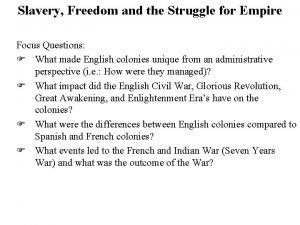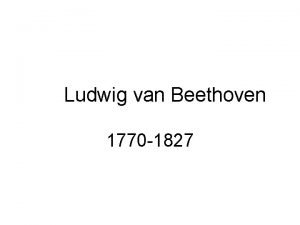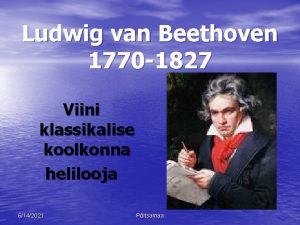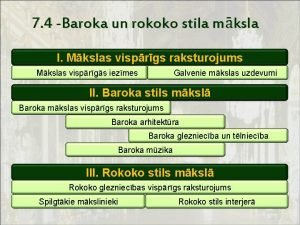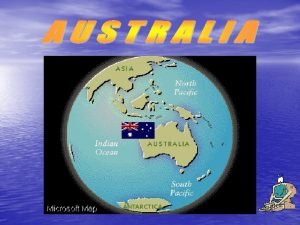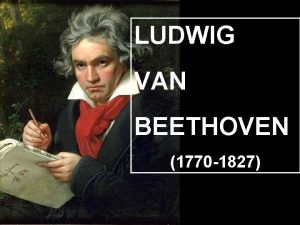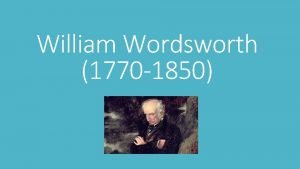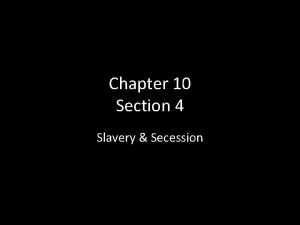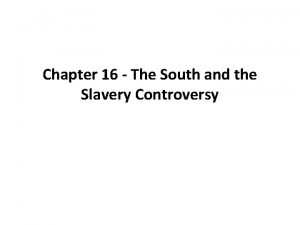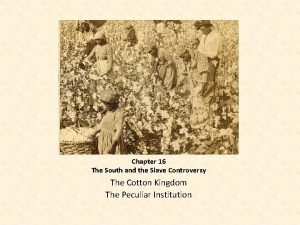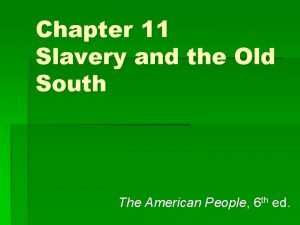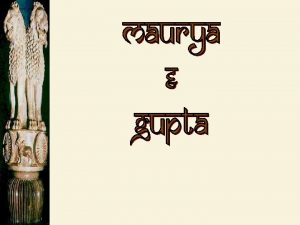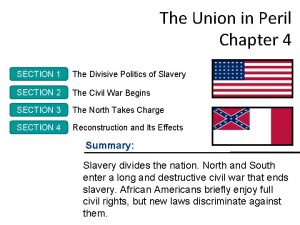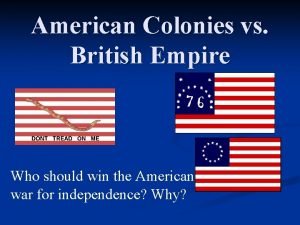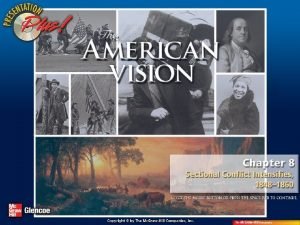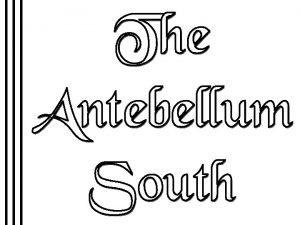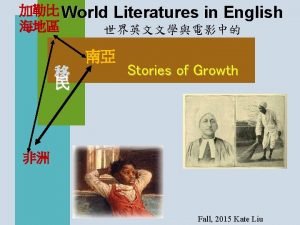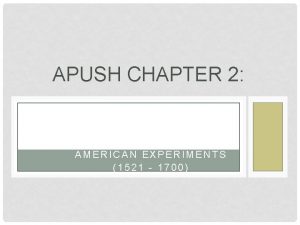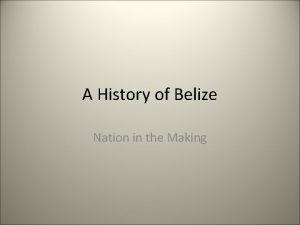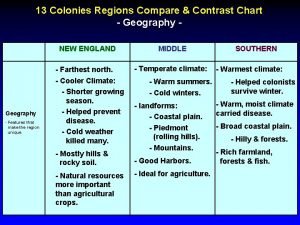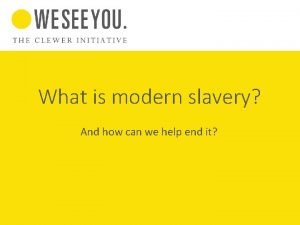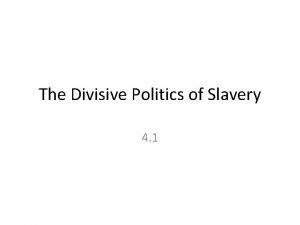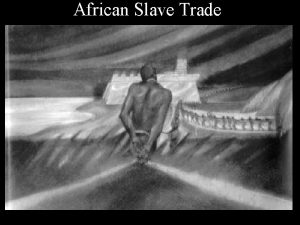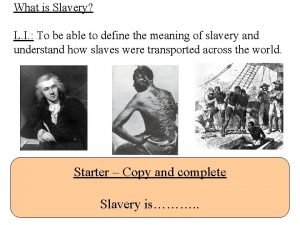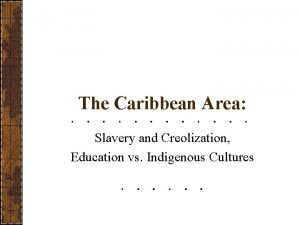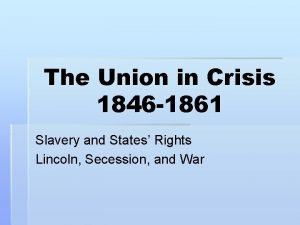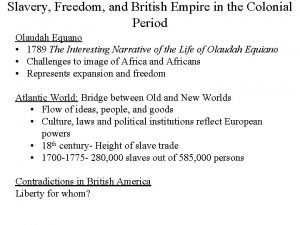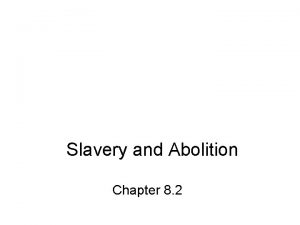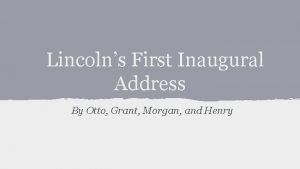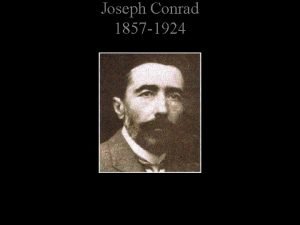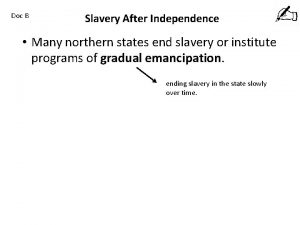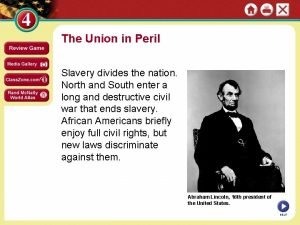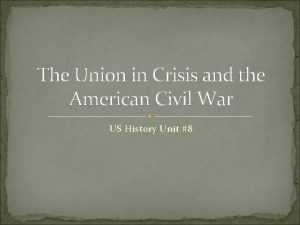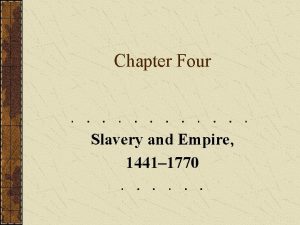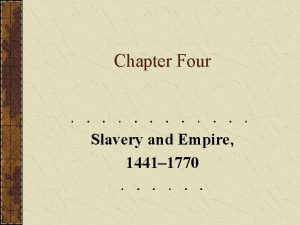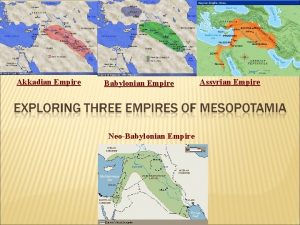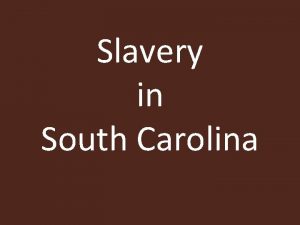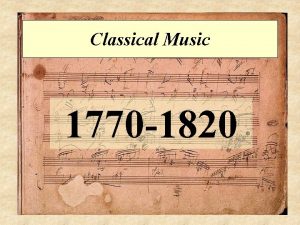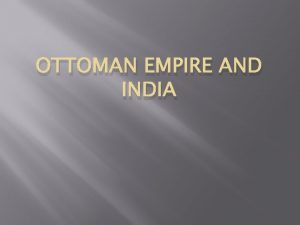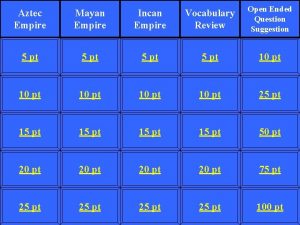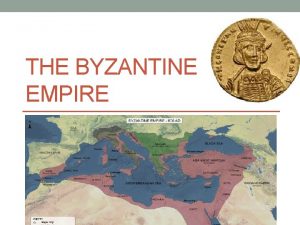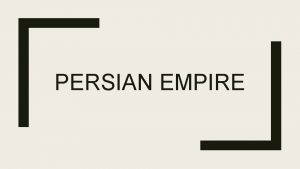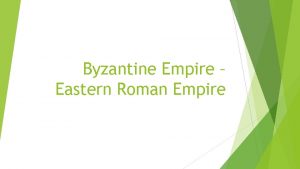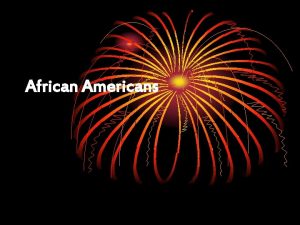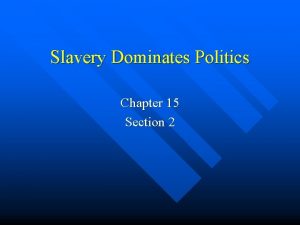Chapter Four Slavery and Empire 1441 1770 The
















































- Slides: 48

Chapter Four Slavery and Empire, 1441 -1770

The Beginnings of African Slavery

Sugar and Slavery z Before the arrival of Europeans, Africans were source of slaves for the Islamic world. z In 1441, the Portuguese opened the European trade by bringing slaves to their sugar plantations on the island of Madeira (off the northwestern coast of Africa). z The expansion of sugar production to the New World increased the demand for slaves. z By 1600, Sugar and slaves were the core of the European colonial system in the Caribbean and Brazil.

West Africans z Slaves came from well-established societies of West Africa. z More than 100 ethnic groups lived along the West African coast. z Extensive trade networks created wealth, which stimulated the rise of military empires that wanted to control the wealth

z Household slavery was an established institution in Africa, but not necessarily a permanent condition. z Most became slaves as criminal punishment or because they were captured in war z Allowed to marry, children were born free Nigeria 24% Angola 24% Ghana 16% Senegal/ Gambia Guinea. Bissau Sierra Leone Other 13% 11% 6% 6%

The African Slave Trade z Map: The African Slave Trade, p. 83 z. The movement of Africans across the Atlantic was the largest forced migration in history. z. Between ten and eleven million African slaves came to the New World z 3/4 of the total arrived from 1701 to 1810

The Slave Trade to British North America z Table: Estimated number of African Imported to British North America, 17011775, p. 84 z Table: Africans as a Percentage of the Total Population of the British Colonies, 1650 -1770, p. 88 z 50% were sent to the Caribbean sugar plantations z 35% to Portuguese Brazil z 10% to Spanish America z 5% (about 600, 000) to the British Colonies of North America (the future USA)

Slavers of All Nations z The control of the trade changed from: y. Portuguese in the 16 th century; y. Dutch in the sugar boom of the 17 th century; y. English who entered the trade in the 17 th century. z Europeans generally made arrangements with local African headmen and chiefs to conduct raids to capture potential slaves.

The Shock of Enslavement z. New World enslavement was an unfathomable shock. z. African raiders or armies often violently attacked villages to take captives. Some individual kidnappings.

z. The captives were marched in shackles to the coast, many dying along the way (suicide, hunger, thirst, exhaustion) z. On the coast, the slaves were kept in open pens or dungeons, where they were separated from their families, branded, and dehumanized

The Middle Passage z The Atlantic voyage was called the Middle Passage. z Slaves were crammed into ships and packed into shelves six feet long and thirty-inches high. z They slept crowded together on their sides. z There was little or no sanitation and food was poor. z Dysentery and other disease was prevalent. z Slaves resisted by jumping overboard, refusing to eat, and revolting. z One in six slaves died during this voyage.



Above: Archival image of the slave trade depicting East African slaves taken aboard HMS Daphne.

Every morning, perhaps, more instances than one are found of the living and the dead fastened together. " John Newton - Slave Ship Captain 'After several voyages, Newton quit the slave trade, became a minister, and wrote the hymn "Amazing Grace, " with its autobiographical line ". . . that saved a wretch like me. "‘

Arrival in the New World z The sale of human cargo occurred in several ways: y A single buyer may have purchased the whole cargo. y Individual slaves could be auctioned to the highest bidder. In the sale process, Africans were closely examined, probed and poked.

Political and Economic Effects on Africa z. The slave trade: yresulted in the loss of millions of people over hundreds of years; yweakened African states who became dependent on European trade; ycaused long-term stagnation of local West African economies yactually prepared the way for European conquest of Africa in the 19 th century.

Slavery in North America z. Map: Slave Colonies of the 17 th and 18 th Centuries, p. 84 z. Slavery spread throughout the Caribbean and southern coast of North America. z. By 1770, Africans and African Americans numbered 460, 000 in British North America: over 20 percent of the total colonial population.

Slavery in the America: Spanish Colonies z. Though the pope denounced slavery it was a basic part of the Spanish colonial labor system. z. The character and nature of Spanish slavery varied by region Gold mining

French Louisiana z. French Louisiana was also a society with slaves, but was more interested in defending its territory than exporting goods z. French settlers used slave labor, but slaves made up only about one-third of the population.

Slavery in the North z Slavery was used in some northern commercial farming areas but only made up about ten percent of the rural population in these regions. z In port cities, slavery was more widespread. z By 1750, the slave and free African populations made up 15 to 20 % of the residents of Boston, New York, and Philadelphia. z Antislavery sentiment first arose among the Quakers of New Jersey and Pennsylvania.

Slave Society in southern North America z African slavery existed, but was not the primary labor system in the Chesapeake region until after the 1670 s. z Between about 1675 and 1700, a slave society developed in the Chesapeake because: y. Increased survival rates meant more indentureds were surviving their terms y. Planters became concerned about future rebellions by former indentured servants after Bacon’s Rebellion y. European immigrants had better opportunities in other colonies, didn’t want to work as servants here y. The Royal English African Company began shipping slaves directly to the region. z Expansion of slavery prompted Virginia to develop a comprehensive slave code, which declared all slaves to be property and called for whippings as punishment for many different “crimes”

The Tobacco Colonies z Tobacco was the most important commodity produced in 18 th century North America, accounting for 25 % of the value of all colonial exports. z Slavery allowed the expansion of tobacco production since it was labor-intensive. z Using slave labor, tobacco was grown on large plantations and small farms. z Tobacco

The Lower South z South Carolina was a slave society from its founding, starting with Indian slaves z Acquired slaves by encouraging Indian tribes to fight each other (divide and conquer) z Made profit by selling them to other colonies

z. African slaves brought skills and knowledge to grow rice and indigo, which became the major plantation crops of the region

z. Large plantations employing many slaves dominated. z. By 1770, about 80 % of the coastal population of South Carolina and Georgia was African-American.

The Social Structure of Whites in the Slave Colonies z. Southern white society included: ya small elite of wealthy planters; ysome small planters and farmers; and ymany poor renters and tenant farmers.

From African to African-American z. Increasingly, the North American slave population became “Creole” (America born) and created an African American culture. z. African American slaves built the South.

The Daily Lives of Slaves z Most slaves worked in the fields, many had farming experience from Africa z The monotonous diets of corn and pork were varied by vegetables from small gardens, game and fish, and wild plant foods. z On small plantations and farms, particularly in tobacco region of Chesapeake, Africans may have worked along side their masters.

Families and Communities z. In the development of an African. American community and culture, the family was the most important institution. z. Slave codes did not legalize slave marriages and families were often separated by sale or bequest. z. Slaves created family structures: developing marriage customs, naming practices, and a system of kinship.

African-American Culture z An African-American culture, distinct from the cultures of both Africa and white Americans developed in the 1700 s, including an African. American language z Slaves developed a spiritually sustaining African American culture, drawing upon dance, music, religion and oral tradition z Until the “Great Awakening”, large numbers of African Americans were not converted to Christianity.

Colonial Williamsburg interpreters re-enact “jumping the broom” marriage ceremony.

The Africanization of the South z Acculturation occurred in two directions--English influenced Africans and Africans influenced English. z Africanization was evident in: ycooking: barbecue, fried chicken, black-eyed peas, and collard greens; ymaterial culture: basket weaving, wood carving, and architecture; ylanguage: yam, banjo, tote, buddy; and ymusic and dance: banjo.

Violence and Resistance z. The slave system was based on force and violence. z. Africans resisted in the following ways: y. Refusing to cooperate and disobeying orders; y. Mistreating tools and animals; y. Running away; and y. Revolt.

The Stono Rebellion z. In 1739, a group of newly arrived slaves from Angola escaped, raided the armory in Stono, SC and marched to Florida, beating drums to attract other slaves z. Grew to a group of around 100, killed 30 colonists along the way z. Captured and killed by a militia z. Inspired other smaller attempted revolts, prompting the closure of Charleston port to slaves imports for 10 years z. Colonists: newly arrived slaves are dangerous

Slavery and Trade z Map: Triangular Trade across the Atlantic, p. 99 z The slave system and colonialism were the foundation of the British economy. z Colonialism: ycreated a large colonial market for exports, thus stimulating manufacturing z Slavery: ygenerated huge profits that served as a source of investments ysupplying raw goods (cotton) to fuel British industrialization. y***Slave labor made the Americas a success for the British empire***

British Colonial Exports z Table: Value of Colonial Exports by region, annual average, 1768 -1772, p. 104 z. The Chesapeake and Lower South accounted for most colonial exports in the late 18 th century, even though they only had half of the British colonialist population Tobacco wharf

The Politics of “Mercantilism” z. Mercantilism was based on: ythe idea the colonies existed to benefit the mother country ythe economy should be controlled by the government ythe economy was a "zero-sum" game where profits for one country meant losses for another.

British Colonial Regulation z European nations, including Britain, created state trading monopolies to manage the commerce of their empires. z The Navigation Acts passed between 1651 and 1696 created the legal and institutional structure of Britain's colonial system. z 1. Only British ships could transport imported and exported goods from the colonies. 2. The only people who were allowed to trade with the colonies were British citizens. 3. Commodities such as sugar, tobacco, and cotton, which were produced in the colonies, could be exported only to British ports. z The Wool, Hat, and Iron Acts prohibited the colonies from producing these items, which could also be produced in Britain, so that they would not be competition for British manufacturers

z Great Britain also did not allow colonial tariffs, banking, or local coinage. z Some British interests wanted more stringent restrictions on what the colonies produced, but, as colonial trade increased, most British came to agree that it would be silly to tamper with such a successful system, since it ultimately benefited the mother country z So, Britain pursued a policy of ”Salutory Neglect” between 1700 and 1760: laws against what they considered “good business” in the colonies were ignored

The Colonial Economy z The colonial economy grew rapidly. z New England shipbuilding was stimulated by southern trade. z The greatest benefits for northern port cities came from: yparticipating in the slave trade to the South and West Indies; and ytrading foodstuffs for sugar in foreign colonies. z Between the 1730 s and 1770 s, the commercial economies of the North and South were becoming integrated.

z. Many African-Americans feel a sense of disconnect from their own past. Their ancestors were stolen from Africa, given the names of white masters, and their families were broken up again and again. z. Using primary sources and new DNA evidence, historians have been able to give some African-Americans a piece of their history back. z Assignment: Society and Culture (Where Historians Disagree) in skills packet is due next class!!!

Multiple Choice and the APUSH exam z The multiple-choice section will contain a number of sets of questions, with between two and five questions per set, that ask students to respond to stimulus material, a primary or secondary source, including texts, images, charts, graphs, maps, etc. This stimulus material will reflect the types of evidence that historians use in their research on the past. z There will be 55 questions to answer in 55 minutes z The terms quizzes that have short-answer questions will also have 4 multiple-choice questions z Often more than one choice seems good, but you must pick the best one z There is no penalty for guessing

The Stimulus:

The Questions:

The Answers: z 3) B z 4) C

Slavery and Empire, 14411770

Chapter Focus Questions z How did the slavery system develop? z What was the history of the slave trade and the Middle Passage? z How did communities develop among African Americans in the eighteenth century? z Why was slavery more common in the American South and the Caribbean z What connections existed between the institutions of slavery and the colonial system of the eighteenth century? z What was the economic relationship between Britain and its American colonies
 Jan van eyck (1390-1441)
Jan van eyck (1390-1441) Slavery freedom and the struggle for empire
Slavery freedom and the struggle for empire 1770-1827
1770-1827 1770-1827
1770-1827 Fragonārs
Fragonārs 1770 james cook
1770 james cook Ludwig van beethoven (1770-1827)
Ludwig van beethoven (1770-1827) He was born in bonn germany
He was born in bonn germany Did you notice something
Did you notice something Hegel
Hegel William wordsworth was born in
William wordsworth was born in Chapter 10 section 4 slavery and secession
Chapter 10 section 4 slavery and secession Chapter 16 the south and the slavery controversy
Chapter 16 the south and the slavery controversy Chapter 16 the south and the slavery controversy
Chapter 16 the south and the slavery controversy Chapter 11 cotton slavery and the old south
Chapter 11 cotton slavery and the old south Chapter 11 cotton slavery and the old south
Chapter 11 cotton slavery and the old south Venn diagram of mauryan and gupta empires
Venn diagram of mauryan and gupta empires Chapter 16 lesson 2 challenges to slavery
Chapter 16 lesson 2 challenges to slavery Chapter 4 section 1 the divisive politics of slavery
Chapter 4 section 1 the divisive politics of slavery American empire vs british empire
American empire vs british empire Byzantine empire vs roman empire venn diagram
Byzantine empire vs roman empire venn diagram Lesson 1 slavery and western expansion
Lesson 1 slavery and western expansion The south and the slavery controversy
The south and the slavery controversy What is coloniazation
What is coloniazation Shapes with straight sides
Shapes with straight sides Palmer hayden
Palmer hayden Chattel slavery apush
Chattel slavery apush Slavery in belize
Slavery in belize The 13 colonies compare and contrast
The 13 colonies compare and contrast When was the 13 colonies formed
When was the 13 colonies formed How to calculate tfr
How to calculate tfr Rooney family slavery
Rooney family slavery The divisive politics of slavery
The divisive politics of slavery Slavery grievance (modified) answer key chart
Slavery grievance (modified) answer key chart Slave iron muzzle
Slave iron muzzle Slavery meaning
Slavery meaning Pan-africanism apush definition
Pan-africanism apush definition Colonial slavery apush
Colonial slavery apush Uncle tom’s cabin
Uncle tom’s cabin Slavery debates
Slavery debates Slavery
Slavery Nat turners rebellion apush definition
Nat turners rebellion apush definition Election of 1860 pie chart
Election of 1860 pie chart Heart of darkness quotes racism
Heart of darkness quotes racism Slave states
Slave states Slavery divides the nation
Slavery divides the nation How did bleeding kansas embody the slavery controversy
How did bleeding kansas embody the slavery controversy Worse than slavery political cartoon
Worse than slavery political cartoon Slavery divides the nation
Slavery divides the nation

